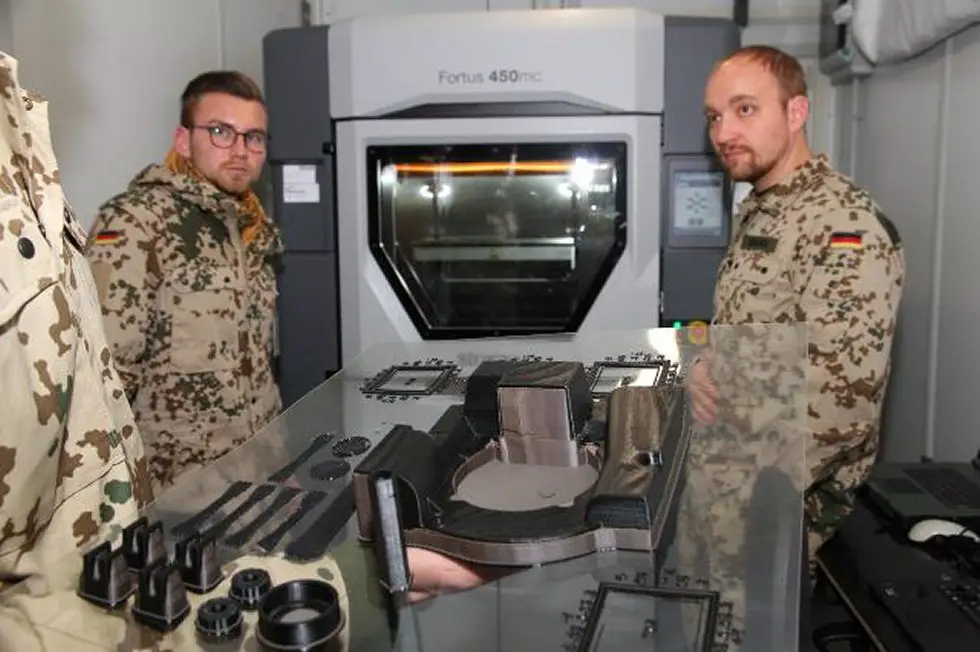This is something that US aircraft carrier crew members have been knowing for a while: a spare part is not available on site and cannot be procured in time, neither by logistics nor by industry? Just print it!

The printing plate is removed from the printing chamber after printing and subsequently processed further (Picture source: Bundeswehr/PAO Resolute Support)
Sometimes, an urgently needed spare part is not available aboard and it would be both too expensive and too time-consuming to send an aircraft fly to a base where it could be obtained via the logistical supply chain. This is why 3D printers have been installed in US aircraft carriers. And these are able to print impressively large objects in a wide variety of appropriate materials.
The same technique is spreading among the ground forces in some large-scale operations. It is the case for the NATO-led Resolute Support operation in Afghanistan. The foundations for the use of this technology have been laid in Mazar-e Sharif in what is commonly called the “maintenance mile”. By means of 3D printing, individual requirements from the soldiers on operations can be fulfilled more quickly.
The Logistics Company in Camp Marmal is currently testing a 3D printer. The dream of manufacturing parts just in time, several thousands of kilometers away from home, is becoming a reality. This vision forms the core of a project between the Bundeswehr Logistics Command and the Federal Office of Bundeswehr Equipment, Information Technology and In-Service Support (BAAINBw) to further develop the Bundeswehr logistic system. Together with the soldiers in Mazar-e Sharif and the Bundeswehr Research Institute for Materials, Fuels and Lubricants (WIWeB), this future technology is currently being tested on operations as a pilot project.
In this particular Bundeswehr research institute, the 3D printing center of the Bundeswehr was opened by State Secretary Dr Katrin Suder on 17 February 2017. Ideas concerning 3D printing in the Bundeswehr are initially tested there under coordination by BAAINBw, which is responsible for armament tasks. Subsequently, they are tested in practice with the field units. This what is now happening in Afghanistan.
A lot of work had to be completed before the first spare part could be printed in Northern Afghanistan. Major work steps included testing and materials investigations in Germany, transport of the printer to the mission country, and setting up both infrastructure and workplace within the Logistics Company. “We are freight forwarder, technician, warehouse manager, dispatcher, wrecker service and shipping firm for all possible major and minor product categories at the same time”, says Major Sebastian G., who was, until recently, Company Commander of the Logistics Company at TAAC N (Train Advise Assist Command North) in Afghanistan.
In a standard request, a query is initiated in the mission country in which all stocks are checked with a software first. Should no spare parts be available, a request will be sent to the Bundeswehr Logistics Center in Wilhelmshaven. If the depots in Germany have nothing on stock either, civilian companies will be tasked with procuring the spare parts. This process may take several months up to the delivery into the mission country.
“There are two ways to re-establish operational readiness as quickly as possible: to improvise or to ask the 3D printing experts”, says Master Sergeant Marco P., maintenance inspector in Afghanistan. The 3D printing team on operations was given a sample part and asked whether they could manufacture a replacement. Upon inspection of the part it became clear that a construction drawing using CAD software as a print sample would not be practical in the mission country. “However, this is not a problem. We rely on the expertise of the 3D printing center at home in Germany. They got a scanner and the know-how to prepare a print file for us very quickly. As a result, we can reduce the waiting time for the spare part to one week”, Björn N. explains.
The printer gives the opportunity to print parts using different types of plastics and up to a size of 40x30x40 centimeters. For the time being, safety-relevant parts, weapon parts as well as aircraft parts subject to certification may not be printed, however.
“The 3D printer is a pilot project. We are planning to gain experience with it for approximately one year and have started to build up a spare part library”, Staff Sergeant Sascha T. says about his role in the project, who is one of the two operators. “When spare parts are unavailable in the mission country we hope that we can help to ensure that the operational readiness of vehicles and materiel is as high as possible!”, Sergeant Jelto T. adds, who is the second operator.
The 3D printer has been in use since December 2017. First experience shows that parts of little complexity can be designed by the soldiers here on site. Should it become necessary to design complex parts, the soldiers in theater can rely on the experts at home in Germany. The aim is to gain additional experience with this technology in the Resolute Support contingents 10 and 11 and, at the same time, to build up a digital spare part library.














